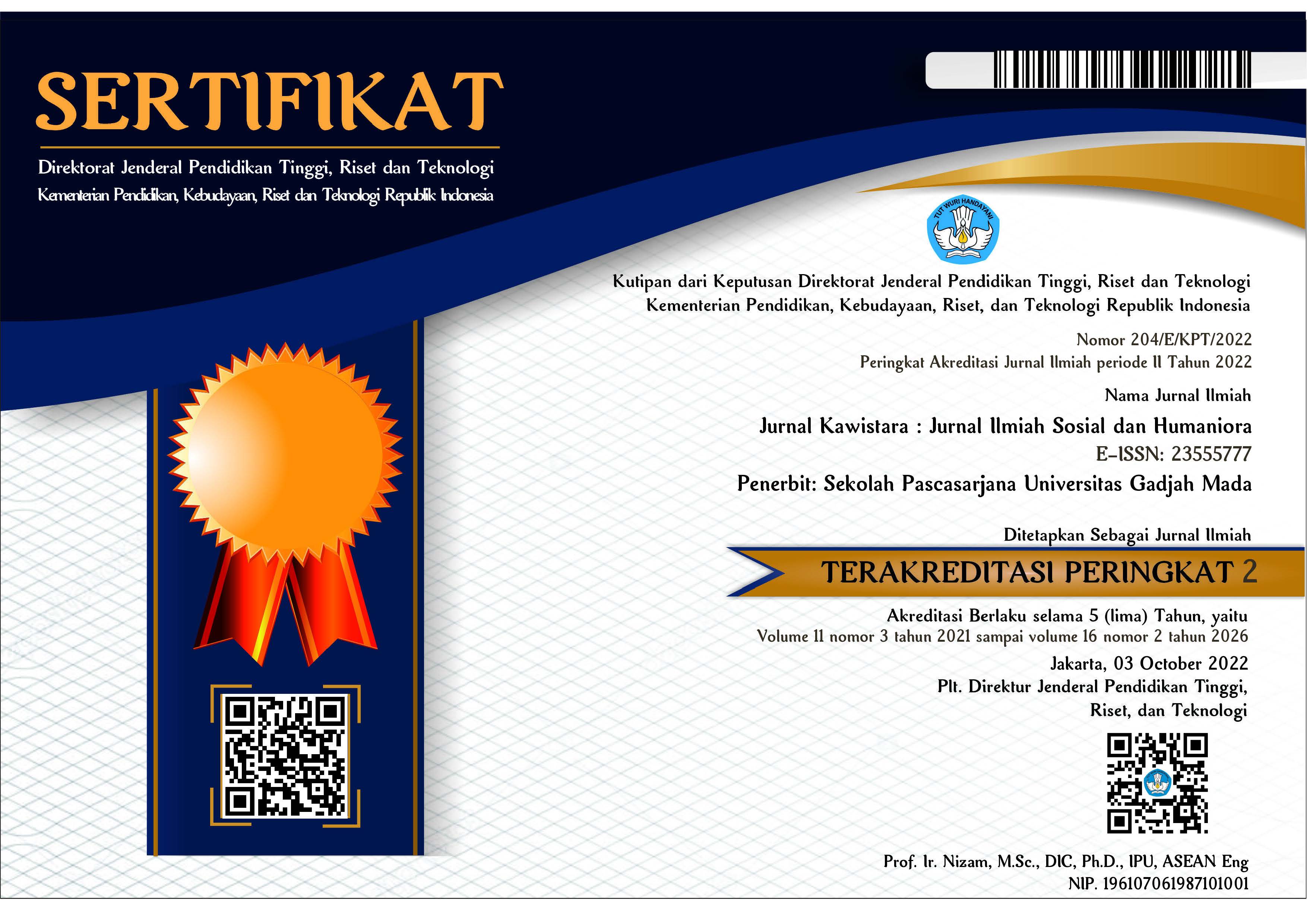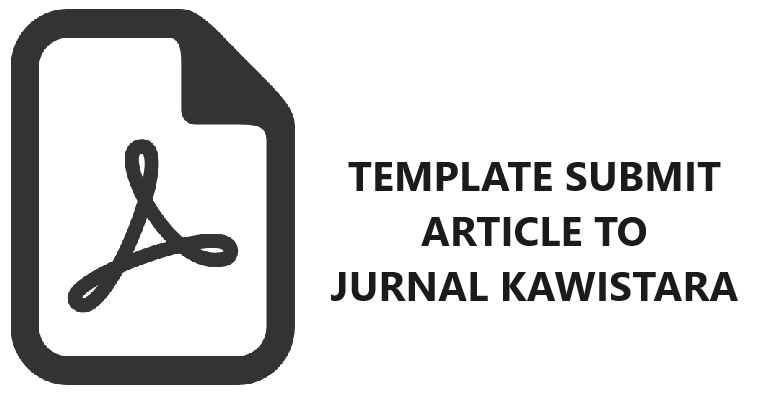Disability and Extreme Poverty in Indonesia: Analysis of National Socio-Economic Survey Data in 2020
Nufi Alabshar(1*), Lina Agustina Pujiwati(2), Titik Munawaroh(3), Zainal Fatoni(4)
(1) Badan Pusat Statistik Provinsi Kalimantan Barat, Pontianak
(2) Badan Pusat Statistik Provinsi Riau, Pekanbaru
(3) Badan Pusat Statistik Kota Yogyakarta, Yogyakarta
(4) Pusat Riset Kependudukan, Badan Riset dan Inovasi Nasional, Jakarta
(*) Corresponding Author
Abstract
Extreme poverty has become a global issue,and several studies indicate its relationship with disability. So far, there has been limited studies related to extreme poverty in Indonesia. Moreover, spesific segments, such as extreme poverty in persons with disabilities, are increasingly challenging to find. This study examines the effect of disability and other control variables on extreme poverty in Indonesia. The data is derived from the 2020 National Socio-Economic Survey (Susenas), which surveyed 1,258,328 individuals. The data was processed using STATA 17 software. The method used in this study is logistic regression by observing disability as the primary independent variable and other socio-demographic variables as control variables. Our analysis show that disability has a positive and significant relationship with extreme poverty. Control variables such as residence area, age group, sex, education, number of household members, marital status, and employment sector also play a role in influencing extreme individual poverty. These findings are expected to be able to enrich literature related
to disability and extreme poverty in Indonesia as well as to provide input for the government in efforts to eradicate extreme poverty by paying attention to vulnerable groups,especially persons with disabilities.
Keywords
Full Text:
PDFReferences
Ackah, C., & Medvedev, D. (2012). Internal migration in Ghana: Determinants and welfare impacts. International Journal of Social Economics, 39(10), 764–784. https://doi.org/10.1108/03068291211253386
Alabshar, N. (2020). Determinan kesejahteraan migran di Indonesia (Analisis data Supas 2015) [Universitas Gadjah Mada]. https://etd.repository.ugm.ac.id/penelitian/detail/185508
Alabshar, N., Giyarsih, S. R., & Pitoyo, A. J. (2020). Factors influencing the prosperity of migrants in Indonesia. Solid State Technology, 63(3), 4358–4372. http://www.solidstatetechnology.us/index.php/JSST/article/view/3546
Alabshar, N., Giyarsih, S. R., & Pitoyo, A. J. (2021). Analisis kesejahteraan migran di Indonesia. Jurnal Litbang Sukowati : Media Penelitian Dan Pengembangan, 4(1), 1–10. https://doi.org/10.32630/sukowati.v5i1.165
Alabshar, N., Giyarsih, S. R., & Pitoyo, A. J. (2023). The impact of migration on optimism and subjective well-being: Evidence from the Indonesian Family Life Survey. Journal of Population and Social Studies, 32, 262–277. https://doi.org/10.25133/JPSSv322024.016
Amalia, F. (2012). Pengaruh pendidikan, pengangguran dan inflasi terhadap tingkat kemiskinan di Kawasan Timur Indonesia (KTI) periode 2001-2010. Econosains Jurnal Online Ekonomi Dan Pendidikan, 10(2), 158–169. https://doi.org/10.21009/econosains.0102.02
Anyanwu, J. C. (2014). Marital Status, Household size and poverty in Nigeria: Evidence from the 2009/2010 Survey Data. African Development Review, 26(1), 118–137. https://doi.org/10.1111/1467-8268.12069
Asongu, S. A., & Le Roux, S. (2019). Understanding Sub-Saharan Africa’s Extreme Poverty Tragedy. International Journal of Public Administration, 42(6), 457–467. https://doi.org/10.1080/01900692.2018.1466900
Badan Pusat Statistik. (2018). Penghitungan dan Analisis Kemiskinan Makro Indonesia Tahun 2018. BPS.
Badan Pusat Statistik. (2019). Konsep dan Definisi Susenas Maret 2020. Badan Pusat Statistik.
Badan Pusat Statistik. (2021). Data dan Informasi Kemiskinan Kabupaten/Kota 2021. BPS.
Banks, L. M., Kuper, H., & Polack, S. (2017). Poverty and disability in low-And middleincome countries: A systematic review. PLoS ONE, 12(12), 1–19. https://doi.org/10.1371/journal.pone.0189996
Barrett, C. B., Carter, M. R., Chantarat, S., McPeak, J. G., & Mude, A. G. (2012). Altering poverty dynamics with index insurance: Northern Kenya’s HSNP. SSRN Electronic Journal, November, 1–2. https://doi.org/10.2139/ssrn.1845508
Becker, G. S. (1994). Human capital: A theoretical and empirical analysis, with special reference to education (3th Ed). In Notes and Queries. University Of Chicago Press. https://doi.org/10.1093/nq/s1-IV.92.83-a
Brady, D., & Parolin, Z. (2020). The levels and trends in deep and extreme poverty in the United States, 1993 – 2016. Demography, 57(6), 2337–2360.
Brown, C., & van de Walle, D. (2021). Headship and poverty in Africa. The World Bank Economic Review, 35(4), 1038–1056. https://doi.org/10.1093/wber/lhaa024
Cahyono, S. A., Jariyah, N. A., & Indrajaya, Y. (2006). Karakteristik sosial ekonomi yang mempengaruhi pendapatan rumah tangga penyadap getah pinus di Desa Somagede, Kebumen, Jawa Tengah. Jurnal Penelitian Sosial Dan Ekonomi Kehutanan, 3(2), 147–159. https://doi.org/10.20886/jpsek.2006.3.2.147-159
Carrillo, S., & Bermúdez, M. (2016). Father’s perceptions of their role and involvement in the family : A qualitative study in a Colombian sample. Revista Costarricense de Psicologia, 35(2), 101–118.
Chant, S. (2007). Gender, generation and poverty: Exploring the “Feminisisation of Poverty” in Africa, Asia and Latin America. Edward Elgar Publishing Limited.
Dartanto, T., & Nurkholis. (2013). The determinants of poverty dynamics in Indonesia: Evidence from panel data. Bulletin of Indonesian Economic Studies, 49(1), 61–84. https://doi.org/10.1080/00074918.2013.772939
Daru, A., & Irawati, D. Y. (2017). Analisis dampak partisipasi perempuan dalam usaha sektor informal terhadap pemberdayaan perempuan berdasarkan koefisien kontingensi Cramer. Jurnal Teknik Industri HEURISTIC, 14(2), 123–138.
De Laat, P. (2021). The Effects of household size on household poverty in sub-Saharan Africa. Radboud University.
Elwan, A. (1999). Poverty and disability: A survey of the literature (Social Pro). The World Bank.
Fatmawati, F., & Preatin, P. (2022). Extreme Poverty trap in Kalimantan Barat. SOCIA: Jurnal Ilmu-Ilmu Sosial, 19(2), 32–41. https://doi.org/10.21831/socia.v19i2.52555
Gooding, K., & Marriot, A. (2009). Including persons with disabilities in Social Cash Transfer programmes in developing countries. Journal of International Development, 21, 685–698. https://doi.org/10.1002/jid
Groce, N., Kett, M., Lang, R., Trani, J., Groce, N., Kett, M., Lang, R., & Trani, J. (2011). Disability and poverty: The need for a more nuanced understanding of implications for development policy and practice. Third World Quarterly, 32(8), 1493–1513. https://doi.org/10.1080/01436597.2011.604520
Hardiyanto, A. (2022). Determinan kemiskinan ekstrem di Pulau Papua tahun 2021: analisis multilevel logistik biner. Politeknik Statistika STIS.
Hastuti, Dewi, R. K., Pramana, R. P., & Sadaly, H. (2020). Kendala mewujudkan pembangunan inklusif penyandang disabilitas. https://smeru.or.id/sites/default/files/publication/wp_disabilitas_in_0.pdf
Imai, K. S., Cheng, W., & Gaiha, R. (2015). Agricultural growth, poverty and inequality in developing countries. Development (Basingstoke), 58(2–3), 230–236. https://doi.org/10.1057/s41301-016-0009-1
Islam, K. N. (2012). Prioritizing “Universal Primary Education” without Post Basic Education in eradicating extreme poverty - A public policy perspective in Bangladesh. Studies on Asia, Series IV,(31846), 85–119. https://castle.eiu.edu/studiesonasia/documents/seriesIV/Islam_Studies_Oct2012.pdf
Kemenkes Republik Indonesia. (2018). Laporan nasional Riskesdas 2018. Badan Penelitian Dan Pengembangan Kesehatan. http://repository.bkpk.kemkes.go.id/3514/
Kemensos Republik Indonesia. (2020). Kemensos dorong aksesibilitas informasi ramah penyandang disabilitas. https://kemensos.go.id/kemensos-dorong-aksesibilitas-informasi-ramah-penyandang-disabilitas
Kett, M. (2020). Horizon 2020 : Global issues in disability and inclusivity in developing countries. International Health : Opportunities for Challenge-Led Innovation.
Lerman, R. I. (2002). Impacts of marital status and parental presence on the material hardship of families with children. July.
Lucas, R. E. B., & Stark, O. (1985). Motivations to remit : Evidence from Botswana. Journal of Political Economy, 93(5), 901–918.
Medeiros, M., & Costa, J. (2008). Is there a feminization of poverty in Latin America ? World Development, 36(1), 115–127. https://doi.org/10.1016/j.worlddev.2007.02.011
Nisa’i, S. W. N., & Pierewan, A. C. (2017). Determinan kesejahteraan subjektif pada lanjut usia di Indonesia. Jurnal Pendidikan, 1–10.
Noerdin, E., Agustini, E., Pakasi, D. T., Aripurnami, S., & Hodijah, S. N. (2006). Potret kemiskinan perempuan. Women Research Institute.
Page, L., & Pande, R. (2018). Ending global poverty: Why money isn’t enough. Journal of Economic Perspectives, 32(4), 173–200. https://doi.org/10.1257/jep.32.4.173
Pemerintah Republik Indonesia. (1997). Undang-Undang Nomor 4 Tahun 1997 tentang Penyandang Cacat. Pemerintah RI.
Pemerintah Republik Indonesia. (2011). Undang-Undang Nomor 19 Tahun 2011 tentang Pengesahan Convention on The Rights of Persons with Disabilities (Konvensi Mengenai Hak-hak Penyandang Disabilitas). Pemerintah RI.
Pemerintah Republik Indonesia. (2016). Undang-Undang Nomor 8 Tahun 2016 tentang Penyandang Disabilitas. Pemerintah RI.
Pinilla-Roncancio, M. (2015). Disability and poverty: Two related conditions. A review of the literature. Revista Facultad de Medicina, 63(3), S113–S123. https://doi.org/10.15446/revfacmed.v63n3sup.50132
Pratama, N. B., Purnomo, E. P., & Agustiyara. (2020). Sustainable Development Goals (SDGs) dan pengentasan kemiskinan di Daerah Istimewa Yogyakarta. Sosiohumaniora: Jurnal Ilmu Sosial Dan Humaniora, 6(2), 64–74.
Putri, A. D., & Setiawina, N. D. (2013). Pengaruh umur, pendidikan, pekerjaan terhadap pendapatan rumah tangga miskin di Desa Bebandem. E-Jurnal EP Unud, 2(4), 173–180.
Saputri, A. (2021). Social capital and household poverty in Indonesia. Jurnal Kawistara, 11(3), 252. https://doi.org/10.22146/kawistara.v11i3.66012
Sari, A. K. (2013). Analisis pengaruh tingkat pendidikan, pertumbuhan ekonomi, dan upah terhadap pengangguran terdidik di Sumatera Barat. Jurnal Ekonomi Pembangunan, 1(2), 1–8. http://dx.doi.org/10.24036/jkep.v1i02.122
Sengupta, A. (2010). Human rights and extreme poverty. Economic and Political Weekly, 45(17), 85–93.
Setyari, N. P. W., Bendesa, I. K. G., & Saskara, I. A. N. (2019). Proporsi adat budaya di Bali dan pengaruhnya terhadap kesejahteraan masyarakat lokal. Jurnal Kawistara, 9(1), 91. https://doi.org/10.22146/kawistara.36526
Shaukat, B., Javed, S. A., & Imran, W. (2020). Wealth index as substitute to income and consumption: Assessment of household poverty determinants using Demographic and Health Survey data. Journal of Poverty, 24(1), 24–44. https://doi.org/10.1080/10875549.2019.1678550
Singh, K., & Gangal, V. K. (2015). Micro insurance in India: A gizmo to vehicle economic development & alleviate poverty and vulnerability. IOSR Journal of Economics and Finance, 6(2), 14–20. https://doi.org/10.9790/5933-06211420
Sritutur, F. F. (2023). Kontribusi hubungan kemiskinan dan disabilitas netra: Studi kasus di Indonesia dengan menggunakan data IFLS tahun 2014. Jurnal Kependudukan Indonesia, 17(2), 237. https://doi.org/10.14203/jki.v17i2.756
Subroto, G. (2014). Hubungan pendidikan dan ekonomi: Perspektif teori dan empiris. Jurnal Pendidikan Dan Kebudayaan, 20(3), 390–400. https://doi.org/10.24832/jpnk.v20i3.318
Takasaki, Y. (2020). Impacts of disability on poverty: Quasi-experimental evidence from landmine amputees in Cambodia. Journal of Economic Behavior and Organization, 180, 85–107. https://doi.org/10.1016/j.jebo.2020.09.027
Taufiq, N. (2022). Penciri kemiskinan ekstrem di 35 kabupaten prioritas penanganan kemiskinan ekstrem. Seminar Nasional Official Statistics, 1, 895–904.
Thomas, P. (2005). Disability, poverty and the Millennium Development Goals: Relevance, challenges and opportunities for DFID (Issue June). Cornell University ILR School. www.disabilitykar.net
Tian, J., & Ma, M. (2023). Does disability necessarily lead to poverty? International Journal of Frontiers in Sociology, 5(1), 1–7. https://doi.org/10.25236/ijfs.2023.050101
Trani, J.-F., & Loeb, M. (2012). Poverty and disability: A vicious circle? Evidence from Afganistan and Zambia. Journal of International Development, 24, S19–S52. https://doi.org/10.1002/jid
United Nations. (2019). Disability and Development Report. Realizing the Sustainable Development Goals by, for and with persons with disabilites. United Nations.
United Nations. (2011). Disability and the Millennium Development Goals: A review of the MDG process and strategies for inclusion of disability issues in Millennium Development Goal efforts. In United Nations Publications. http://www.un.org/disabilities/documents/review_of_disability_and_the_mdgs.pdf
United Nations. (2022). End poverty in all its forms everywhere. https://unstats.un.org/sdgs/report/2022/goal-01/
Utomo, K. S., & Haryani, T. N. (2019). Mengurai feminisasi kemiskinan kepala rumah tangga perempuan. Jurnal Bimbingan Konseling, 3(1), 15–23.
Waite, L. J., & Gallagher, M. (2000). The case for marriage: Why married people are happier, healthier and better off financially. Doubleday. https://hrs.isr.umich.edu/publications/biblio/5271
Weeks, J. R. (2007). Population: An introduction to concepts and issues (10th ed). Pre-PressPMG.
WHO & The World Bank. (2011). World Report on Disability. World Health Organization. https://doi.org/10.2196/14170
Widinarsih, D. (2019). Penyandang disabilitas di Indonesia: Perkembangan istilah dan definisi. Jurnal Ilmu Kesejahteraan Sosial, 20(2), 127–142.
Wilson, A. (2016). New roles for urban models: Planning for the long term. Regional Studies, Regional Science, 3(1), 48–57. https://doi.org/10.1080/21681376.2015.1109474
World Bank. (2021). Disability inclusion. https://www.worldbank.org/en/topic/disability#1
World Bank. (2022). Poverty and shared prosperity: Correcting course. The World Bank Groups.
Wulandari, N. R., Harafah, H. L., & Saenong, Z. (2016). Faktor-faktor yang mempengaruhi kemiskinan rumah tangga di Kota Kendari tahun 2014. Jurnal Progres Ekonomi Pembangunan, 1(1), 111–119.
Yamin, S., & Dartanto, T. (2016). Pengentasan orang miskin di Indonesia: Peran modal sosial yang terlupakan. Jurnal Ekonomi Dan Pembangunan Indonesia, 17(1), 88–102. https://doi.org/10.21002/jepi.v17i1.656
Yeo, R. (2001). Chronic poverty and disability. In Chronic Poverty Research Centre Working Paper (Issue 4).
Yeo, R., & Moore, K. (2003). Including disabled people in poverty reduction work: “nothing about us, without us.” World Development, 31(3), 571–590. https://doi.org/10.1016/S0305-750X(02)00218-8
Article Metrics
Refbacks
- There are currently no refbacks.
Copyright (c) 2024 Nufi Alabshar; Lina Agustina Pujiwati; Titik Munawaroh; Zainal Fatoni

This work is licensed under a Creative Commons Attribution-ShareAlike 4.0 International License.
Jurnal Kawistara is published by the Graduate School, Universitas Gadjah Mada.











